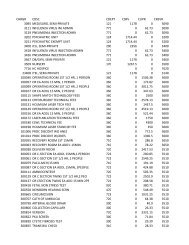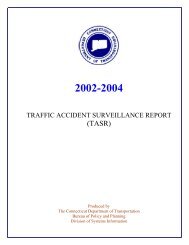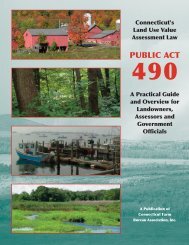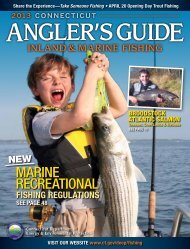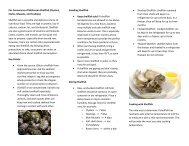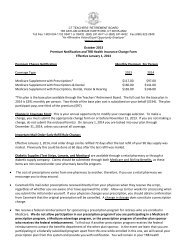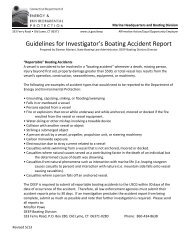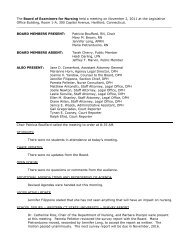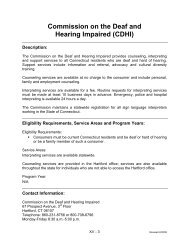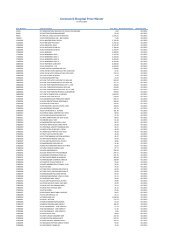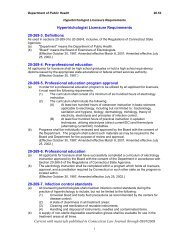The Connecticut Motorcycle Operator's Manual - CT.gov
The Connecticut Motorcycle Operator's Manual - CT.gov
The Connecticut Motorcycle Operator's Manual - CT.gov
Create successful ePaper yourself
Turn your PDF publications into a flip-book with our unique Google optimized e-Paper software.
46 THREE-WHEEL SUPPLEMENT<br />
SUPPLEMENTARY<br />
INFORMATION FOR<br />
THREE-WHEEL VEHICLES<br />
Many states require a separate license<br />
endorsement to operate a three-wheel<br />
vehicle. This requires the rider to pass<br />
both a written and a skills test. <strong>The</strong><br />
purpose of this supplement is to help<br />
prepare riders to complete the written<br />
exam for a three-wheel vehicle license<br />
or endorsement. This information is<br />
provided in addition to that off ered in<br />
the fi rst part of this <strong>Motorcycle</strong> Operator<br />
<strong>Manual</strong> (MOM), so when preparing to<br />
take the written test, begin by reading<br />
the information on 2-wheel motocycles<br />
thoroughly. It provides information on<br />
safe operation of your vehicle in traffi c.<br />
This supplement contains information<br />
specifi c to the safe operation of a threewheel<br />
vehicle, including both three-track<br />
vehicles and motorcycles with sidecars.<br />
KNOW YOUR VEHICLE<br />
Due to the many three-wheel vehicle<br />
designs available on the market today,<br />
standards suitable for testing may vary.<br />
However, vehicles should conform to<br />
standards determined by your state. In<br />
general, three-wheel vehicles will have<br />
the following specifi cations:<br />
1. Three wheels leaving two or<br />
three separate tracks during<br />
straight line operation.<br />
2. <strong>Motorcycle</strong>-based conversion or<br />
design with:<br />
• Handlebar steering<br />
• <strong>Motorcycle</strong>-type controls<br />
arranged with the standard<br />
layout. Convenience alterations<br />
such as a single brake pedal or<br />
lever control, automatic clutch,<br />
or automatic transmission are<br />
allowed.<br />
• Saddle seating<br />
– Seating in which the rider/<br />
passenger straddles the<br />
vehicle.<br />
– If designed for a passenger,<br />
the passenger must be<br />
seated behind the operator<br />
(or in a separate passenger<br />
compartment in the case of a<br />
motorcycle with sidecar).<br />
3. Turning diameter of the vehicle<br />
at its widest point must be less<br />
than 40’.<br />
4. <strong>The</strong> vehicle meets all applicable<br />
federal on-road vehicle standards.<br />
<strong>The</strong> following vehicles are not<br />
included in this defi nition, and<br />
therefore testing requirements may not<br />
be applicable. Always refer to your<br />
state Department of Motor Vehicles,<br />
Department of Licensing or other<br />
appropriate state regulatory agency for<br />
exact regulations regarding testing for:<br />
• Automotive hybrids or<br />
automotive conversions<br />
• Vehicles with automotive<br />
controls or seating<br />
• Vehicles with front or rear<br />
mounted engines (engines must<br />
be mounted mid-frame below the<br />
rider to be considered motorcyclebased)<br />
• Vehicles with enclosed or semienclosed<br />
riding compartments<br />
• <strong>Motorcycle</strong>s or scooters with two<br />
close-set wheels in front (contact<br />
patches less than 18.1 inches<br />
apart) that lean and maneuver like<br />
standard, single-track, two-wheel<br />
motorcycles<br />
or<br />
• Vehicles with any other departure<br />
from the above standards.




